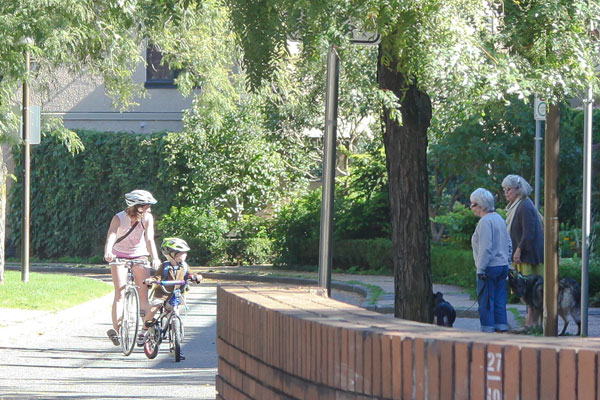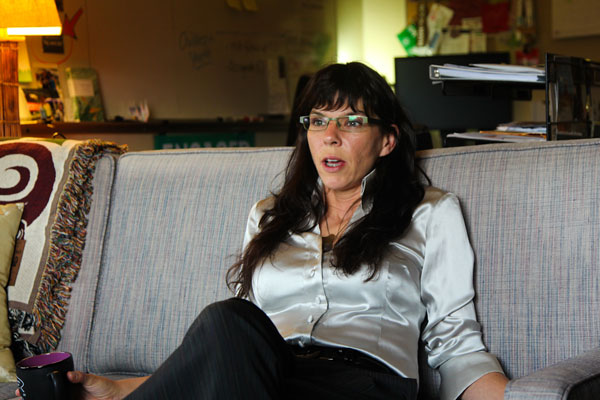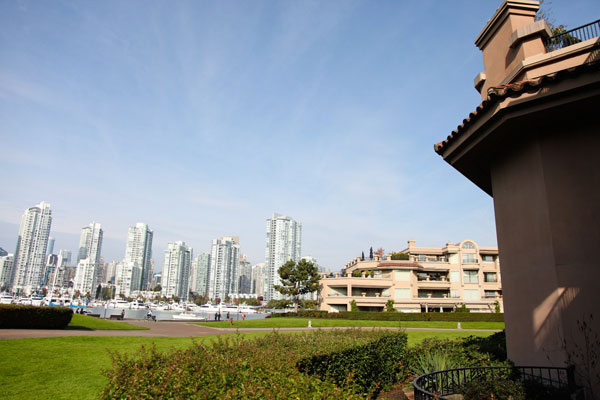Since its founding in the 1970s, False Creek South's residents have quietly enjoyed the community's waterfall, its duck ponds and cloistered courtyards, its green expanse of lawn in Charleson Square, its view of the changing skyline of downtown between the Granville and Cambie bridges.
Unknown to most other Vancouverites, the nearly 6,000 people living in a dozen housing co-ops mixed in equal proportion with condo owners and subsidized renters -- all on once-industrial city-leased land -- was a conscious experiment in neighbourhood-scale urban design, since studied and applauded by planners and architects from around the world.
It hasn't all been a cake-walk for the occupants of the aging low-rise complexes curled around car-unfriendly streets, but community satisfaction seems high. Now though, False Creek South's residents are getting a different type of jitters.
As the entire city wrestles with stubbornly skyrocketing housing costs and development pressures, the expiry dates of the series of city land leases that made the project possible are coming into sight.
When they do, absent other agreements, use of the land, now worth many times its 1970s value, goes back to the city. The first lease expires in 2022, with others following it.
Nine years might seem like a long time to most people, but in urban planning terms it's almost the blink of an eye. And unfortunately for False Creek residents, when it comes to financing and mortgages, banks see it the same way.
"People started talking about how they couldn't sell, because the banks wouldn't give them a mortgage on a unit with only 25 years left," explains Kathleen McKinnon, president of the False Creek South Neighbourhood Association, who lives in one of the Creek's few condos on freehold (owned) land. "They couldn't get loans to repair their buildings."
Architect Monty Wood worked for the firm commissioned to build the community. He helped design a row of waterfront condos and when they were done, he purchased one of them -- as did eight architect friends. He moved out recently after a bank turned down a loan application because of the impending end of the city's land lease.
The problem, he believes, was that in the 1970s there was little legal experience with selling real estate on leased land. "They had to invent stuff," Wood said over coffee. "They thought, 'That's good enough.'
"We had all been promised at the beginning, 'Don't worry about the end of the lease. All your property values are going to hold up because there's going to be a buy-out clause.' The intention was to maintain the property value. But 35 years later, it's turned out that's not the case."
It's not only condo owners, who make up a third of the community, who are anxious. In the community's co-ops, the largest cluster of the form in British Columbia, were among the first to raise an alarm about the staggered expiries of False Creek's patchwork of leases.
Like many British Columbia building owner's, the co-ops were hit hard by the ‘leaky condo' problem of previous decades, and forced to spend years under tarps and millions of community dollars. Some of that was defrayed by the remains of federal funding committed at the project's inception. But that fund is running out within the decade. And borrowing for new repairs is hampered by uncertainty over the co-ops' land tenure.
"It's an urgent issue," said Rider Cooey, one of False Creek Co-op's original members. "As the countdown to lease end approaches, it will become harder and harder to borrow money for maintenance issues, and harder and harder for condo owners to get people to buy in if there may not be lease renewal or -- if there is -- that circumstances may change for the worse and it gets more expensive."

Another problem could be put down to the experiment's very success. Nobody wants to leave and make space for newcomers. Many of the young families who moved in originally have shrunk as children moved away, but parents remain in suites larger than they need -- in part because there's nowhere in the neighbourhood for them to down-size. Equally worrying is the lack of accessible housing for seniors.
"The future is the same big question mark for everybody who lives here," said Beryl Wilson, founder and editor of the community's newspaper The Creek, which stopped printing in 2002.
The best use of city land?
From the City of Vancouver's standpoint, the termination of the area's leases over a period of more than a decade starting in 2022 pits preserving an internationally recognized design project that is already providing a substantial chunk of low-cost rental and co-op living, against an opportunity to leverage the (now) high-value waterfront real estate it owns along south False Creek into making greater inroads on its affordable housing objectives.
"Here we are 30 or 40 years later and the leases are starting to stare us down," Kent Munro, Vancouver's assistant planning director, told The Tyee Solutions Society. "We want to ensure in the long term for the city's supply of affordable housing, that the people living in it are the ones most in need.
"The leases coming up are an opportunity to have a rethink of that."
But while the loss of False Creek South's affordable housing stock would set the city back from its goals, the fact that it's such an "idyllic little niche," Monty Wood fears, may lower its priority at city hall. "It doesn't gain a lot of sympathy from the rest of the residents of the municipality," he worries. "Why should one per cent of the population of Vancouver be handed another silver platter?"
Although city staff say that planning for the Creek's future won't start until sometime in 2014 -- when resources are hopefully freed up from increasingly contentious community plans under way elsewhere -- they say they have met with residents.
Residents themselves, under the aegis of their neighbourhood association, have formed a "Re*plan" committee to preemptively pitch solutions to the lease issue. The community has even hired its own architects and planners to develop ideas for dealing with the impending funding, lease and aging crises -- effectively kickstarting its own planning conversation without waiting for the city.
Although many residents have raised the spectre of development pressure from the astronomical property values surrounding the Creek, Councillor Andrea Reimer, stickhandling the matter at city hall, insisted the survival of the False Creek South project is paramount.
Sure, prices have "gone substantially up" across the water in Yaletown, she admitted, "but the point of owning that big chunk of land wasn't to make a lot of money off of it as a city. It was to ensure the long-term stability of the community.

"The challenge down there is going to be, without federal or provincial dollars, being able to renew the co-op housing, the low-end-of-market rental housing, the quite a bit of supportive housing down there. We have to figure out how to renew the buildings that are there. That is going to create some pressure on that land base."
Reimer stepped in as city council's point person for the neighbourhood because her Vision Vancouver colleague, Councillor Geoff Meggs, is a resident there.
Meggs, Reimer and Munro all say they are impressed by Re*plan, and the neighbourhood association's foresight in taking inventory and pitching solutions with time to go before the end of their leases.
"It's great they're raising the flag on this," Munro said. "On one hand 10 to 15 years, to some people, can feel a long way away, but it sneaks up on you. As anxious as they are, we are too.
"We're anxious and eager to roll up our sleeves and address these issues, to get this work done well in advance of the leases coming up."
Residents rise up
The residents have brainstormed a number of proposals, chief among them to consolidate the multiple leases into a single umbrella leaseholder. They've also taken inspiration from a land trust agreement between the BC Cooperative Housing Federation and the city: that kind of arrangement would also create a governance structure for the community to make more of its own planning decisions. But the idea is largely untested in Canada.
Residents would also like to see their renewed leases run longer than the original batch 40 years ago. Monty Wood cited European leases which last 99 years or, in some cases, even for 999 years. Longer terms, he argues, would boost a sense of ownership amongst residents, promote longevity, and help ease future uncertainty about many leases coming to a close at different times.
At a community meeting this summer, residents packed a common room off False Creek's Sitka Square to discuss the Re*plan committee's suggestions for surviving the lease expiries. While differences were apparent among leasehold condo owners, co-operative members and the small minority of the Creek's strata owners who are on private land -- styled "freeholders" -- most residents in attendance said they would support greater density.
That willingness stands in contrast to the numerous protests and resistance elsewhere to city hall's densification proposals.
"This place can absorb some density," Wood explained. "The first design, as wacky and ingenious as it is, turned out not to be perfect. It does need a tune-up after 35 years."
For instance, building on undeveloped land along 6th Ave. or near the Olympic Village Canada Line station could both help fund renovations on existing buildings, and perhaps provide accessible retirement housing for longtime Creek residents who want to stay in the neighbourhood they have built and cherished for decades.
"It's not often we have residents coming forward asking for density, if you look at the other plans!" the city's Kent Munro said, with a laugh. "When they raised that in our early meetings and discussions, I was intrigued.
"It's an interesting sort of eyes-wide-open view of planning, right? They're realists. Nobody's going in thinking this area is going to change drastically. We want to find a way, and they do, to address these issues, to maybe accommodate some growth, but to keep the essential character of the neighbourhood the way it is."
But rumours of some older units being demolished to make way for such density has some residents anxious. Some non-market renters, who are not members of the neighbourhood association under its original mandate, feel left out of the discussions over their future.
"We've heard rumours of this place being pulled down and something else going up, at some point in time, not anytime soon I don't think," said Wilma DeVito, a longtime renter in the Vancoeverden Court affordable housing complex.
"Hopefully not. If it's more than three stories high, it'll change too much. Anytime there's a tower, there's more isolation I think.
"I definitely care about what happens," DeVito says. "I feel... not that I own it, but I certainly feel I belong. You don't feel that anywhere else; we're all part of this island."
So, if the city supports False Creek's survival, can't it simply renew the leases outright and avoid the uncertainty?
"In my mind, it's definitely more a question of how?" Reimer said. "In a day and age like this, when there is no money from other levels of government, it's so imperative that we're able to hold onto the significant but still insufficient resources that we have to be able to support more affordable housing in the city.
"We're fighting so hard to build more -- it would be odd to give up that opportunity in an area like this where we have had such good success."
Neighbourhood Association president Kathleen McKinnon is "hopeful" about city negotiations, but said the key question is how to ensure the Creek remains an affordable place to live for its residents in all the housing formats, considering the property values nearby.
"There's any number of possibilities of what the city could do," McKinnon said. "They could decide to tear some buildings down. Even if we get lease extensions, what's it going to cost to stay?"
But beyond False Creek South's clusters and enclaves, some are already expressing reservations about how City Hall might handle False Creek South's lease renewal. Architect Bill McCreery -- who ran unsuccessfully for city council in 2011 under the Non-Partisan Association banner -- was instrumental in overseeing the neighbourhood's development in the 1970s as a member of False Creek's planning committee.
At the time, he was elected to Vancouver Parks Board under Mayor Art Phillips' since-defunct municipal party, The Electors' Action Movement (TEAM), which aborted the city's downtown freeway plans in favour of a vision of "more humane, more people-oriented" development, he told Tyee Solutions Society.
Now, as 2014 elections loom, McCreery has resurrected TEAM and vowed to campaign against Vision Vancouver's development model, which he fears could ruin his forebear's False Creek legacy.
"I find whole thing quite scary," he said. "I share (Reimer)'s concern about (affordable housing), but what I don't share is the way they go about doing it.
"Essentially, it tends to be heavy-handed and inappropriate. That does indeed give the residents, and the rest of the city, a good deal to be concerned about. Certainly their track record is that they start plunking in high-rises out of scale and context ... It's complete overkill around density."
Most of False Creek South's residents express pride in living in such a rare example of creative urban design. But as they struggle to secure its affordable future, most doubt it will ever be replicated.
For Monty Wood, the 1970s era of visionary urban planning is over. Certainly, he argues, it hasn't been attempted again on this scale. But while the glass towers reaching skyward across the Creek are proof of the booming success of Vancouver's real estate industry, he muses, for all its flaws the south shore remains a testament to the "social success" of a long-ago experiment to design for equality, diversity and green living.
In fact, the Re*plan committee's demographic research showed that, following the founding vision of an equal income mix matching the city's mix, False Creek South today retains its economic diversity.
For her part, Beryl Wilson has a guarded view born of a long life. "Things change over 30 years," she said, placing her stack of yellowing The Creek newspaper clippings back onto a chair. "And you're no longer pioneers, you're no longer newcomers.
"It would be lovely if [False Creek South] continued, but I wouldn't bet on it. Who knows how politicians will think 20 years from now?"
To see this series in its entirety, go here. ![]()
Read more: Housing, Urban Planning + Architecture















